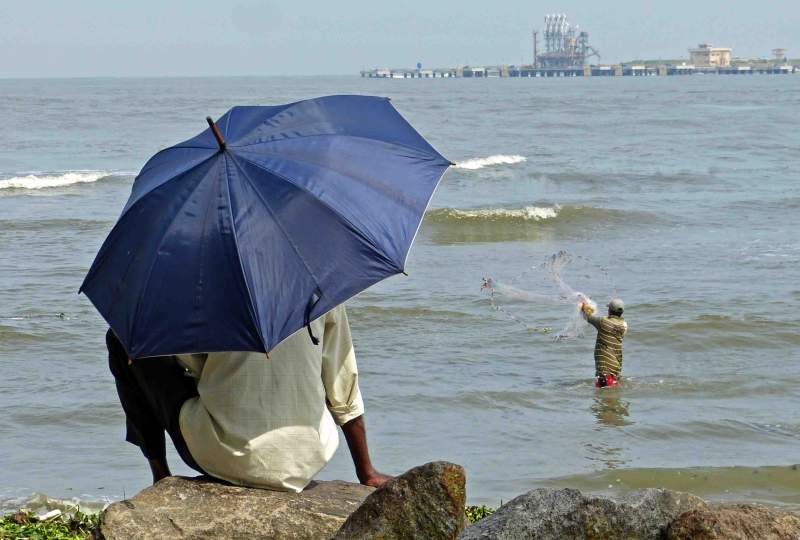The Vizhinjam Port development project has been widely debated in Kerala since it was first conceived over five decades ago. Alphonsa Joseph writes about the crux of these discussions—the social impact of such projects on the local communities.
Alphonsa Joseph

A coastal land filled with coconut trees, rocky mountains, and small hills surrounded by the marvellous beauty of the Arabian sea, Vizhinjam port lies on the outskirts of Thiruvananthapuram and has a history that dates back to 1000 BCE. It was a busy commercial port city during the reign of Ay, Chera and Chola dynasties. During the colonial era, the British understood the importance of Vizhinjam as a commercial centre and used it as a base for their business in Thiruvananthapuram. In the last century, the Regent Rani Sethu Lakshmi Bayi took initiatives for the development of the port at Vizhinjam under the supervision of Sir C.P. Ramaswami Aiyyer, the Diwan of Travancore at the time. An amount of Rs. 375 Lakhs was sanctioned by the Regent for the preparation of a project for the same. However, the project got stalled after the consolidation of Travancore-Cochin states.
In 1955-57, an expert committee prepared a report for supporting the port at Vizhinjam. Subsequently, it became a fishing harbour. The Vizhinjam fishing harbour was the brainchild of a Swedish fishing harbour expert, Carl. R. Bjerke, who conceived a project with three phases in 1960. Construction started in 1962 with the installation of a 12 feet high pillar.

Controversy ensued soon after when residents in the area were displaced from their homes and land without any rehabilitation process. Due to protests by the people, the land acquisition process was terminated by the then Government of Kerala. However, the government did not agree to compensate the displaced people. A local parish—Our lady of Good Voyage—stepped in and distributed their land to the displaced people, and provided houses in various settlements.
Despite protests, the Government of Kerala sanctioned the first phase of the fishing harbour between 1968-1974. The second and third phases were sanctioned during 1977 and 1983, respectively. During the second phase, forty hectares of land was acquired and many fishermen were displaced from their land. Again, in the 1990s, discussions on the construction of an international seaport resurfaced. Following protests from the locals and the tourism industry at Vizhinjam, these attempts were abandoned.
On December 5th 2015, the then Chief Minister of Kerala, Oommen Chandy, laid the foundation stone for the Vizhinjam International Deepwater Multipurpose Seaport, with M/S Adani Ports Private Limited as the sole concessionaire operating on a Public Private Partnership (PPP) Model. Being a natural port with 21m water depth, Adani Ports claimed that the dredging and maintenance cost for the port would remain low. However, the uncertainty regarding land acquisition and the displacement of inhabitants continued.
Impacts on Local Livelihoods
Vizhinjam is predominantly inhabited by members of the fishing community, known as Mukkuvar, who rely entirely on the seacoast for their livelihood. There has been no impact assessment from the government authorities regarding the loss of land and livelihood as a result of the project. But locals expect a massive displacement of land and loss of livelihood due to the construction of the port.
The construction of a massive port just 250 meters away from the fishing harbour will destroy the structure of the harbour. More than 25,000 people from the fishing community in and around Vizhinjam depend on this fishing harbour. Accidents involving small fishermen has increased due to the pressure of dredging and reclamation of land. Fishermen are also apprehensive about ships colliding with their smaller boats. They complain that the thriving fish populations and Wadge Banks in the Vizhinjam coastal zone, a fertile fishing ground and a biodiversity hotspot, have disappeared.
The construction of a port at Vizhinjam is an important venture by the previous Congress-led UDF (United Democratic Front) government, with the opposition parties also claiming their role in making this project happen. The local fishing community is not against the development of the port, but is anxious about the future of their livelihood. The Vizhinjam Seaport Project was proposed to be developed in three phases. The total land area to be acquired for all three phases is estimated at 450.59 hectares. This includes the harbour area within breakwater, the water spread area (167 Ha), port infrastructures and ancillaries in land including road and railways (140.42 Ha) as well as port infrastructure in reclaimed land (143.17 Ha). The fishing community has accused the authorities of keeping them in the dark regarding the correct estimates of land acquisition. This has created concern in the minds of the local people and this situation is very critical for them.
Development for whom?
The Vizhinjam port has undergone a massive transformation over the years and the changes have significantly impacted the lives of the locals. But the question of whether this port brings development to the local people or worsens their existing condition is a crucial one. Development projects are inevitable, but governments need to ask, ‘whose development?’ before envisioning and engaging in projects which involve the massive land acquisition and displacement of local people. The fishermen, who are otherwise in favour of development, have a realistic anxiety about losing their livelihood and their concerns are not being responsibly addressed by concerned authorities.
About the Author: Alphonsa Joseph is pursuing her PhD at the Department of Sociology, University of Kerala, Thiruvananthapuram. Her thesis is titled “Re-defining Development-induced Displacement and Rehabilitation: A Socio-Structural Analysis of Vizhinjam International Seaport”. She can be contacted at achurose2012@gmail.com
